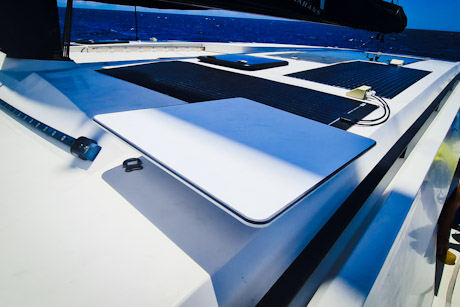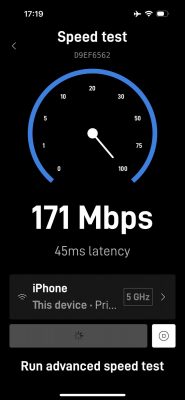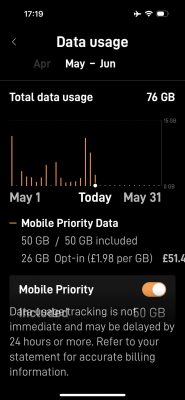When a whole array of satellites were launched up in to orbit to form the Starlink, it opened up a new era of data rich communication, enabling me to write and publish this review somewhere in the middle of the Atlantic Ocean in the same way I would from my office in Southampton.
Starlink Priority Data for boating – tested and reviewed

Starlink Priority Data for Boating, Satellite Broadband
Society demands we are in touch and telling our life stories round the clock. We’re contactable. The phone can ring or ping and we are expected to answer.
The mobile phone addiction is real and I put my hand up to say I lose hours of my day to mindless reading and watching of trivial social media posts. I go sailing to get away from that and go cold turkey so to speak. It’s a kind of cathartic experience. I love being without any rapid communications or expectation of communication for hours or days at a time.
So obviously I’m going to review Starlink Priority data, onboard internet and come back saying this is marvelous.

Specifications:
Data speed:
upload: 8-25+ MBPS
download: 40-220+ MBPS
Latency: LESS THAN 99 MS
data allowance: 50GB,
Cost £206 per month
Conflicted as I am about purist sailing, the Corinthian spirit and so on, I also work professionally onboard clients boats as a skipper and I can see instantly the benefits of having a host of data and information readily to hand at a moments notice. Showing an owner how the weather is looking on a bigger screen helps to discuss our choices of places to go and where they might want to take their boat for a quiet anchorage or port or switch to somewhere else accordingly, if when the port is googled ahead of time and it turns out there’s a bit of an event happening, then we can book restaurants or a marina berth or reserve a mooring buoy capable of supporting a larger vessel. And so on.

The speed is on a par with regular household data upload and download.
Starlink is frankly a revelation.
It doesn’t however replace the need for emergency onboard satellite communications if headed offshore for several days. I wouldn’t want to rely solely on the built in sat comms of Starlink.
It would have been useless on my boat when I dismasted 400 miles away from the Azores, had the satellite dish been damaged. I was very glad I kept a small Iridium phone charged up and ready to use when I needed to call Falmouth to let them know of my predicament. It was reassuring to have a stand alone back up. As far as I know Starlink haven’t produced a stand alone small portable satellite phone that works from it’s own battery power. I have written another guide to satellite comms for safety use onboard and for compliance in category 1 offshore events.

someone needs to help me with my phone addiction!
So far, so mostly excellent. The main fly in the otherwise silky smooth ointment powering my phone addiction, has been the inaccuracy in the data recorded as having been used.
With every smidgen of data control applied to my phone, laptop and the phones of my fellow crew onboard, we somehow managed to smash through 5GB simply sending an email and receiving a few whatsapp messages (without images). This doesn’t seem possible.
A look into my phone data consumption shows roughly 500Mb used over the 15 days we’ve used the Starlink. The same goes for the others. All are showing minimal data used from their wifi connections. So somewhere along the line, there’s a data discrepancy which needs ironing out. Something to the tune of 50GB. Between us we reckon we’ve used no more than 2 or 3GB.
50GB is quite a lot of data. I work using mobile data on a daily basis as I work remotely, often from a boat, often from other locations in the UK or my home in the Azores and I rarely use more than 35GB in a month, which includes video meetings daily and and large quantities of image and video uploads. (and plenty of mindless internet scrolling, oh those addictive reels…)

Given that the monthly allowance for the lowest band of Priority data is 50GB, you’ll guard this carefully. Additional costs above this are roughly £2 per GB.
Starlink have been contacted for a breakdown of their impression of our data usage but haven’t supplied useable info yet.

so long and thanks for all the fish
Power Hungry
A major consideration on whether this marvelous bit of kit really is the marvel you desire is your ability to power it.
Some people have managed to hack the system and power it from a domestic battery bank with DC-DC conversion from 12v or 24v up to the 48v that it uses, but most simply have to power it using an inverter as the system works on 110 or 240v mains power. If the losses of an inverter don’t worry you then go ahead, let’s look at the power drain.
For the high efficiency flat dish I’ve reviewed here, we’re looking at around 100w or more to keep it switched on. If you have a large lithium battery bank, like the boat I’m on, then super or a genset that you use a lot. You’re good to go.
If though, also like me you sail a smaller, low powered sail boat with minimal electrical options onboard, then you might find it zapping your batteries at a startling rate. So what’s great for one boat, really isn’t so great for another. There’s much lower powered satellite comms options, but none offer the speed and quantity of data as the Starlink.
This Starlink has spoiled me something rotten. I’m beginning to hate myself for how much I like it. Now I need to find a better way to go cold turkey from my phone addiction.




